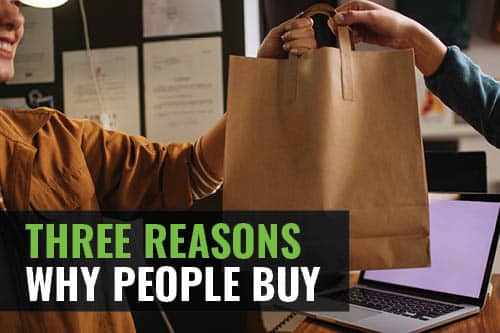Three Reasons Why People Buy

Consumer behavior, once thought of as whimsical, has developed into a science. Sure, consumers can be fickle, but understanding the basic motivations behind purchasing decisions can play a huge role in your company’s success.
1. Want To Be Well Liked/Need To Impress
An overwhelming majority of consumers want to be well-liked or at least feel a sense of belonging. This is a fundamental human emotion. Your favorite sports team wears uniforms to signal that they are something special. They belong. The consumer must perceive your product or service as capable of solving a need while signaling that it is OK to do so. Branding is very important to this segment.
There has been a huge uptick in celebrity branding and the use of influencers in advertising. If you recognize a TV personality or trust an influencer who is endorsing a product, they are suggesting that you will be well-liked as a result. Nike and Air Jordan built an entire brand on this concept. You could become a member of a very special group if you own these products.
The need to impress is another human emotion understood well by successful companies. Coined by a sociologist in 1899, conspicuous consumption is a public display of economic power. People purchase high-end items not only for their usefulness but also for their status. Consumers will gladly pay more for stature.
Porsche and Land Rover are more than automobiles, they represent status. They signal not only do you like to drive but that you have arrived. These brands do not market to everyone. They have a very small target market and understand their audience well.
2. Seek Personal Pleasure/Desire To Own
You may not know it but there is conflict in your mind as you contemplate a purchase. Your irrational mind suggests that you must have this item while the rational part of your brain works to justify it. For quick-decision buying, the desire to own something completely cancels out any counterargument. Free product samples or test-driving new automobiles are proof of this concept in action.
Retailers understand the desire to own and capitalize on it. In fact, consumers are more likely to make additional purchases in a physical store versus online shopping. That is because they can touch, hold and feel the product. The feedback is immediate. Winemakers will intentionally make their bottles heavier because the average consumer equates weight with quality.
For online businesses, a great marketing message can compel consumers to purchase products to satisfy their desire to own. It is very important for these businesses to reduce any roadblocks or friction that can slow the purchasing process down. They want to buy from you so make it easy for them.
3. Have a Desired Outcome
This is the easiest of consumer behaviors to understand. It is about reducing discomfort in any form. Pharmaceutical companies spend billions of dollars annually first describing the source of discomfort and then offering a unique solution. They top this off with a call to action, “Talk to your doctor to see if this product is right for you.”
But sometimes it is even simpler than that. People buy meals at restaurants to satisfy their hunger or because it may be more convenient than cooking at home. Many consumers in this category purchase based on necessity. More than 145,000 service stations exist across America because people need to get somewhere and largely rely on petroleum to achieve that outcome.
Find what people need and provide it and you will be successful. If the public is not sure what they need, you must create a compelling story that creates a need. Apple is very good with this type of marketing and you can be, too.
Final Thoughts
As you can see, branding, messaging and storytelling are interwoven into why consumers buy. Successful companies understand consumer behavior and tailor their messages accordingly. And while consumers may sometimes behave unpredictably, the factors that influence their purchasing decisions should guide your marketing strategy.
This article was previously published on July 25, 2012 and updated on May 15, 2023.

